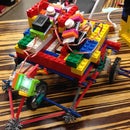Introduction: Chibitronics Plant Monitor
The Problem: Living in the desert makes it a challenge to
maintain a healthy plant. Winter heating, summer heat, and summer air conditioning all take their toll on remoiving the moisture from the air. In our household the mortality rate of house plants has been dismal.
The Solution: Devise a way to monitor the water level of house plants, and signal when watering is necessary.
You will need:
· A Chibitronics Microcontroller
· Some Chibitronics LED stickers
· Some Chibitronics stickey-back Copper Tape
· A Potted houseplant
· A Chibitronics 3V button battery
· Some Duct Tape
· Some clear packing tape.
Process:
Plan ahead for where each component will best fit. Think it through. The Microcontroller should be situated somewhere in the middle of all the components.
** This was a failed attempt at creating a plant monitor using Chibitronics. - I am posting this Instructable on behalf of another Chibitronics Instructables Build Night participant. This Instructable will be updated as the project progresses and improves **
Step 1: Step 1: Apply Copper Tape
The Copper tape should connect the Microcontroller to each component around it that is in the circuit. It also needs to attach to the battery outside the pot.
These 2 copper strips need to go over the lip of the pot, and down the inside of pot. They should be about 1/4" apart as they go down and stick to the inside wall of the pot.
Step 2: Step 2: Apply Stickers to the Pot
Follow the Microcontroller template to determine what connects to what. Also,
pay attention to the current flow (+-) with regard to the polarity of each
connection.
Finally the LED stickers should be prominently placed so as to make it easily
noticed when lit.
Test all connections for the proper functionality per the Microcontroller template.
Once tested, secure the various components with the clear packing tape, and the
button battery with the Duct tape.











